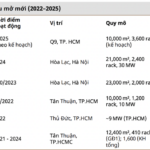The Vietnamese media landscape is at a pivotal moment in 2025, with significant transformations taking place. As the industry embraces a comprehensive restructuring, marked by mergers, name changes, organizational streamlining, and operational model shifts, it also celebrates the upcoming centenary of the Vietnamese Revolutionary Journalism (June 21, 1925 – June 21, 2025).
This evolution is not merely a necessity but a pivotal turning point for Vietnamese journalism in the new era of digital communication. Technology, data, and information consumption patterns are constantly evolving, posing challenges and opportunities for the industry.
A critical question arises: How can Vietnamese journalism maintain its role in guiding political and social discourse while swiftly adapting to the competitive digital media environment? Additionally, how can financial sustainability be ensured amid the growing emphasis on autonomy?
Streamlining Organizations: Enhancing Efficiency, Preserving Identity, and Amplifying Impact
Mr. Tu Luong, Director of the Vietnam Television Center in Ho Chi Minh City (VTV9), emphasized the dual importance of streamlining during a seminar on “Lean, Agile, and Robust Journalism” organized by VTV9 on June 12, 2025. He stated, “Streamlining is not just a strategic direction but an urgent action in the context of news organizations’ restructuring efforts.”
According to Mr. Luong, renaming and reorganizing news organizations necessitates a holistic approach that addresses political, legal, and operational factors, with a particular focus on audience identification.
During the streamlining process, the first consideration is establishing standardized naming conventions for merged news organizations. The new name should clearly indicate the entity’s functions, scope of operations, and governing body while prioritizing the retention of reputable media brands to avoid confusion among audiences. It is also essential to ensure that the name does not create confusion regarding management levels or blur the lines between mainstream media and internal newsletters.
Another critical aspect is maintaining the unique identity of each news organization. The name and brand identity should be closely aligned with their political mission and target audience while remaining simple, memorable, and adaptable to the digital media landscape. The naming strategy should be optimized for various platforms, including the internet, social media, and digital applications.
Mr. Luong asserted that the ultimate goal of streamlining is not merely reducing the number of entities but enhancing the quality of information and ensuring the continued leadership and guidance of the Party and the State in journalistic activities.
Alongside organizational streamlining, addressing the “journalistic economics” conundrum is recognized as a significant challenge in the current context.
Mr. Dao Quang Binh, Chairman of the Board of Directors, CEO, and Editor-in-Chief of Vietnam Economic Magazine/VnEconomy, emphasized the necessity of digital transformation as the core of resolving the journalistic economics puzzle. As a pioneer in organizational streamlining, Vietnam Economic Magazine/VnEconomy implemented a unified editorial model in 2020, immediately after its transformation, and was also a trailblazer in digital transition.
With the recent technological boom, newsrooms are accelerating their digital transformation journeys. In this race, speed and innovation are key differentiators, providing a competitive edge to those who dare to be different.
“We must grasp the essence of technology,” Mr. Binh emphasized. “We have truly harnessed the spirit of self-reliance and technological empowerment, and technology, in turn, has enabled us to fulfill our mission.”

Mr. Nguyen Ngoc Toan, Editor-in-Chief of Thanh Nien Newspaper, highlighted the significant shifts in news consumption patterns and their impact on the operations and revenue of newspapers. Young audiences, in particular, are moving away from print media, favoring social media for their news consumption. This shift has led to a loss of brand recognition for traditional media outlets.
“World newspapers have experienced a decline in traffic since the COVID-19 pandemic, except for those that have made significant improvements in content quality,” Mr. Toan observed. “The situation in Vietnam is similar. Moreover, recruiting young reporters for political and social journalism remains a significant challenge.”
He also noted that businesses are redirecting their advertising efforts to cross-border platforms, further reducing revenue for newspapers. Only a handful of large domestic enterprises continue to invest in PR campaigns in mainstream media, highlighting the financial challenges faced by the industry as a whole.
Journalistic Economics: Innovating Mindsets for Autonomy and Sustainable Growth
Addressing the perceived conflict between journalistic duties and economic imperatives, Mr. Toan asserted, “There is no conflict. These two tasks must be carried out in parallel, employing distinct methods and targeting distinct audience segments.”
While the draft amended Press Law initially mentions the concept of a “leading multimedia press and communication organization,” Mr. Toan believes the current approach favors entities like VTV, VOV, and Vietnam News Agency. He suggests expanding opportunities for potential national and international media outlets to rise to prominence.
Additionally, the “organization” model should be based on economic autonomy and influence rather than solely focusing on state management units.
A notable addition to the draft amended Press Law is the inclusion of three new revenue streams for journalism: profits from equity investments, orders from state agencies, and fees from individuals publishing scientific research articles. While welcoming these provisions, Mr. Toan recommended providing detailed guidance, particularly on the accountability of leaders when invested enterprises incur losses.
He also suggested that state agency orders should be tailored to the strengths of each newspaper, and budget allocation should be based on transparent and clear communication effectiveness criteria.
“There is a need for solutions to address policy inconsistencies in financial management for non-business units, especially in technology investment, income enhancement, and recruitment of high-quality personnel,” Mr. Toan proposed. “Additionally, mechanisms and policies should encourage news organizations to evolve into communication-technology service enterprises, fulfilling political tasks through state orders.”
To adapt to the trends in digital media and increasing competition, Thanh Nien Newspaper has undergone organizational and operational changes. The newspaper has focused on organizing communication events to leverage its reputation and connect with its target audience. Editorial processes have been redirected to prioritize the digital platform, with increased financial and human resource investments.
Ultimately, the goal of streamlining is not just to reduce the number of entities but to enhance the quality of information and ensure the continued leadership and guidance of the Party and the State in journalistic endeavors.
‘The Steel King’ Hoa Phat’s Digital Transformation: From ‘Data Deserts’ to a ‘Real-Time Digital Landscape’
A steel company’s key competitive advantage when it comes to exports is the traceability of its products. For every batch of steel exported to the US, Hoa Phat can now trace back the exact ore batch, the shift that produced it, and the quality of each process.
The Power of Persuasion: Crafting a Compelling Headline
“Legislative Body Urges Media to Intensify Propaganda on Central Resolution”
The Speaker emphasized that alongside amendments to the Press Law, the press needs to proactively embrace the digital transformation trend. He urged them to closely follow resolutions 57, 59, 66, and 68 of the Central Committee and take the lead in information dissemination within the context of comprehensive institutional reform.
Digital Transformation for Traditional Market Vendors: Embracing the Nation’s Digital Shift
Small business owners and traders of traditional markets are empowered with digital skills and e-commerce training. They are provided with access to advanced digital technology solutions and subsidized usage costs to expand their market reach.
“Empowering Small Businesses: From Operational Challenges to Digital Transformation.”
On the evening of June 12, the livestream event “Is Retail Management Easy?” hosted by ACB, attracted over 10,000 live viewers, garnered nearly 6,000 comments, and was shared hundreds of times within just 90 minutes of its broadcast. This overwhelming response highlights the keen interest in a topic that, though seemingly familiar, continues to pose challenges for business owners.





















